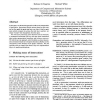Free Online Productivity Tools
i2Speak
i2Symbol
i2OCR
iTex2Img
iWeb2Print
iWeb2Shot
i2Type
iPdf2Split
iPdf2Merge
i2Bopomofo
i2Arabic
i2Style
i2Image
i2PDF
iLatex2Rtf
Sci2ools
COLING
1992
1992
On The Interpretation Of Natural Language Instructions
In this paper, we dLscuss the approach we take to the interpretation of instructions. Instructions describe actions related to each other and to other goals the agent may have; our claim is that the agent must actively compute the actions that s/he has to perfomt, not simply "extract" their descriptions from the input. We will start by discussing some inferences that are necessary m understand instructions, and we will draw some conclusions about action representation formalisms and inference processes. We will discuss our approach, which includes an action represantation formalism based on Conceptual Structures [Jac90], and the construction of the structure of the agent's intentions. We will conclude with an example that shows why such representations help us in analyzing instructions. 1 Making sense of instructions Consider the following three instructions: (la) Go into the other room to get the urn of coffee. (tb) Before you pick it up, be sure to unplug it. (lc) Whe...
Action Represantation Formalism | Action Representation Formalisms | Agent's Intentions | COLING 1992 | COLING 2008 |
| Added | 07 Nov 2010 |
| Updated | 07 Nov 2010 |
| Type | Conference |
| Year | 1992 |
| Where | COLING |
| Authors | Barbara Di Eugenio, Michael White |
Comments (0)

